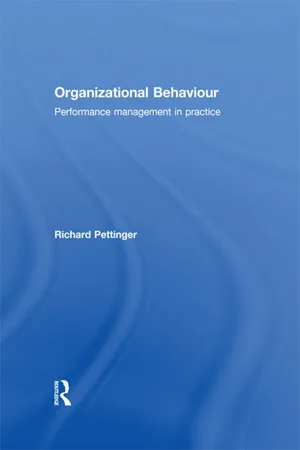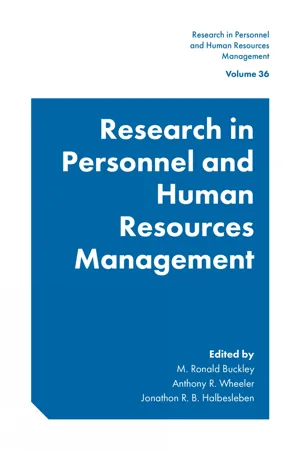Business
Organizational Behavior
Organizational Behavior is the study of how individuals and groups behave within an organization. It encompasses topics such as leadership, communication, motivation, and decision-making. Understanding organizational behavior is crucial for businesses as it helps in creating a positive work environment, improving productivity, and managing conflicts effectively.
Written by Perlego with AI-assistance
Related key terms
9 Key excerpts on "Organizational Behavior"
- eBook - ePub
Organizational Behaviour
Performance Management in Practice
- Richard Pettinger(Author)
- 2013(Publication Date)
- Routledge(Publisher)
Chapter 3 . Organizations have to be capable of responding to changes and pressures in their environment; and they also have to be able to change themselves in order to meet fresh challenges and developments. Organizations have to be capable of accommodating advances in human and technological knowledge, and in harmonizing these to best effect in the pursuit of successful activities.The overall context is bounded by the need for managerial expertise in integrating all of the lessons into a body of understanding that forms the basis for the study of knowing how people think, behave, act and react in a variety of situations.xxivPassage contains an image
1 Introduction
DOI: 10.4324/9780203857595-2Organizational behaviour is concerned with the study of the behaviour and interaction of people in restricted or organized settings. It involves the understanding of, and prediction of, the behaviour of people, and of the means by which their behaviour is influenced and shaped.Organizations are bodies or entities created for a stated purpose. They may consist of one or more people. In the case of the sole trader or single operator, he/she needs to build relationships with suppliers, contractors, customers, clients and the community. For those that consist of more than one person, internal as well as external relationships have to be created and maintained. Organizations therefore consist of individuals, groups and relationships. Objectives, structures, systems and processes are then created to give life, direction and order to activities and interactions.Organizational behaviour is therefore of great concern to anyone who organizes, creates, orders, directs, manages or supervises the activities of others. It is also of concern to those who build relationships between individuals, groups of people, different parts of organizations, and between different organizations themselves because all of these activities are founded on human interaction. - eBook - ePub
Organizational Behavior 3
Historical Origins, Theoretical Foundations, and the Future
- John B. Miner(Author)
- 2006(Publication Date)
- Routledge(Publisher)
Organizational Behavior 3 PART I THEORY, RESEARCH, AND KNOWLEDGE OF Organizational BehaviorWhat is Organizational Behavior? It is a social science discipline—much like cultural anthropology, economics, political science, psychology, and sociology. This means that it utilizes the scientific method to establish truth and to validate its theories. It is a discipline that historically has had its intellectual home in business schools. It is a new discipline relative to the other social sciences, having its origins in the mid-twentieth century. The key points are that it is a science and that it has a history, which, though short, has been quite turbulent.Although the exact boundaries of the discipline are somewhat fuzzy (see Blood 1994), Organizational Behavior’s focus is clearly on the world of organizations. The concern is first with the behavior and nature of people within organizations, and second with the behavior and nature of organizations within their environments. The term Organizational Behavior initially referred only to the behavior and nature of people in organizations. Given the fuzziness of its boundaries, the discipline always had a tendency to stretch beyond that domain, however. By the time it approached twenty-five years of age it clearly had staked a claim to incorporating the behavior and nature of organizations as well (see Miles 1980). This is historically consistent in that both the study of the behavior and nature of people and the study of the behavior and nature of organizations emerged in the business schools in the same places at the same times.In line with its professional school origins, Organizational Behavior is an applied discipline, concerned with matters of practice and application. Despite this orientation, it currently has relatively few members who actually devote their primary professional efforts to the practice of Organizational Behavior in business and other organizational settings; rather, most are concentrated in academia—teaching, writing, and conducting research. In my opinion this is unfortunate; the field would be better off not by reducing its academic efforts, but by expanding its practitioner efforts. We will return to this theme in various ways throughout this book. - eBook - ePub
- Paul Smith, Marilyn Farmer, Wendy Yellowley(Authors)
- 2013(Publication Date)
- Routledge(Publisher)
1
Organization behaviour: an introduction
The only thing worse than slavishly following management theory is ignoring it completely. THE ECONOMIST (1994)The 20th century was the age of the machine ; the 21st century will be the age of people . ROSABETH MOSS KANTER (1989)CHAPTER OUTLINE1 Introduction: the meaning of organizational behaviour2 Differing perspectives on organizational behaviour3 Theory and practice in organizational behaviour4 Levels of organizational behaviour5 The employment relationship6 SummaryCHAPTER OBJECTIVES By the end of this chapter you will understand:• definitions and meanings of organizational behaviour and the importance of the subject• how to evaluate different perspectives on organizational behaviour• the application of theory to practice in organizational behaviour• the main levels of organizational behaviour• the employment relationship.1.1 Introduction: the meaning of organizational behaviour
Organizational behaviour (OB) is a popular subject on many business school degree programmes. It is also taught on a wide range of business and management postgraduate programmes and courses aimed at the practising manager. Yet organizations do not have ‘organizational behaviour departments’ in the same way that they have marketing, HR or accounting departments. What is OB? What does the subject cover? And why might it be considered important? These are some of the questions that will be considered in this chapter, and in the rest of the book.OB can be defined in terms of the study of individuals and groups in organizations. As the second word suggests, one of its principal concerns is behaviour, - eBook - ePub
- Ivan P. Pavlov(Author)
- 2017(Publication Date)
- Routledge(Publisher)
Chapter Three Human Behavior and OrganizationTHE present chapter will focus attention upon the individual employee of governmental organizations, upon the forces that account for his behavior, and upon the influences that the organization brings to bear on him in order to secure his contribution to the organization's tasks. At first sight there hardly seems to be a problem here. If we employ a man to direct activities at a playground, of course he will spend his time each day from nine to five at the playground; of course he will organize and direct play activities there; of course he will carry out the policies formulated by the directors of the organization who are responsible for planning its program. Only the many instances of organization failure—instances where an organization does not carry out its task or where it succeeds at an excessive economic and human cost—warn us that there is really nothing automatic about the process.Organizational Behavior is such an obvious part of everyday experience that we are seldom conscious of the psychological reasons for its successes and failures. We sometimes forget that an organization is a group of people behaving. These people are not tools or machines. They have feelings, hopes, and fears. They get sick, hungry, angry, frustrated, happy, sad. Their behavior is subject to a whole range of influences extending back to their births (and before, many psychologists believe) and impinging upon them from all directions at every moment. Their behavior in organizations is a resultant of all these influences. Some of the more important of the influences will be described in this chapter.Characteristics of Behavior in Organizations
A person can do but a limited number of things at any particular time. However, there are a nearly unlimited number of things he might be doing at that time. To explain a person's behavior, we must understand why he is doing what he is doing in a particular way rather than something else or in another way. - eBook - ePub
- Ray French, Charlotte Rayner, Gary Rees, Sally Rumbles(Authors)
- 2016(Publication Date)
- Wiley(Publisher)
We will refer to issues raised in greater detail throughout the book. The Nature and Scope of OB Defining OB Although there is broad agreement on the subject matter covered by OB, there are some illuminating differences in actual definitions or conceptions of the term. Consider, for example, the varying nuances of meaning contained in two statements taken from leading OB textbooks. The first is this: ‘Organizational behaviour is concerned with the study of people within an organizational setting. It involves the understanding, prediction and control of human behaviour.’ 2 Contrast this with the statement that OB should be viewed: ‘first and foremost as practices of organizing and meaning-making, involving thinking, feeling and acting that are not so dissimilar to everyday life’. 3 The differences can be related to the philosophical stances taken by the authors. The first statement is explicitly managerial; the words ‘prediction’ and ‘control’ emphasize the performance dimension, while the second seems to highlight the subjective experience of organizational actors on their own terms as a worthwhile area for study. For our purposes organizational behaviour is defined as the study of individuals and groups in organizations. This is a stripped-down definition that identifies the core elements of the subject while allowing readers to take insights and evidence from the OB knowledge bank and to use these in a variety of contexts and from eclectic perspectives. While the overall tone of this book is moderately managerial (we welcome situations where the goals of employers and employees coincide and happy workers contribute to legitimate organizational success), we also acknowledge alternative critical perspectives - eBook - ePub
- Brian Lehaney, Phil Lovett, Mahmood Shah(Authors)
- 2011(Publication Date)
- Routledge(Publisher)
Factors in the internal and external environments can affect organizational behaviour and change management. Ineffective change can result in loss of time, resources, money and trust, and these can be disastrous for an organization. Organizational structures have changed radically in the last quarter of the twentieth century. During industrialization, structures tended to be bureaucratic, power came from the top, tasks were of a routine level and most employees were not supposed to take part in decision-making processes. This trend continued directly after the Second World War, when it was initially thought that methods of managing military operations could be used in civilian organizations. It soon became apparent that this was not the case. As Western economies shifted from industry to services, and knowledge workers became more common, different approaches to management had to be developed. Today, employees are not simply practitioners, they now have closer social relations with the external environment, and organizations need to consider employee satisfaction and commitment as a strategic element to increase participation, increase productivity and decrease employee turnover.This chapter discusses concepts of organization structure and behaviour, the practice of organizing within the workplace and some of the human resource functions that relate to OB. Areas of interest include theories of organizations, approaches to management – including classical, scientific and human relations – and contingency theory. The nature of organizations, organizational goals, strategies and responsibilities, managerial behaviour and leadership are covered. Topics include design of structure, objectives, functions, span of control, chain of command, patterns of work, organization structure and change management. The chapter concludes with human resource aspects, such as the individual in the organization, work motivation and rewards.10.3 Organizational culture
Organizational culture may be considered as a set of values, beliefs, understandings and ways of thinking that are shared by members of an organization. Such culture will be taught to new members of the group, and used to help face external problems together and to protect the group from outsiders – for example, to protect resources. Culture is also used to present a common image to those outside the group, to deter people the group may consider undesirable and to attract those the group considers desirable. - eBook - ePub
Rethinking Leadership
A Critique of Contemporary Theories
- Annabel Beerel(Author)
- 2021(Publication Date)
- Routledge(Publisher)
3 Organizational Behavior influences and studies- Introduction
- Evolution of leadership theories
- Psychology and leadership
- Psyche lost
- All things are possible
- Psyche regained
- Scientific management
- Mary Parker Follett
- The human relations movement
- Elton Mayo (1880–1949)
- Peter Drucker (1909–2005)
- Douglas McGregor (1906–1964)
- Abraham Maslow (1908–1970)
- Organizational development
- Definition of OD
- OD as a process
- Roots of OD: Kurt Lewin (1898–1947)
- Rensis Likert (1903–1981)
- Chester Barnard (1886–1961)
- Elliott Jacques (1917–2003)
- David McClelland (1917–1998)
- Learning organizations
- Decline of organizational development
- Herzberg, motivation, and hygiene factors
- Organizational Behavior
- Summary of early theories
- Executive summary
- Questions
- References
Introduction
Since the late 19th century, researchers have engaged in the study of organizations, their processes, how they are led, and the factors that influence human behavior. Psychologists have been at the forefront of this research, and their ideas have influenced managerial styles and techniques over the decades. These research studies were known as studies into Organizational Behavior, and the study of leadership was initially carried out under this rubric.Since the late 1960s, however, due to recognition of the significant influence of leadership on the success and failure of organizations, leadership studies blossomed into a separate discipline with their own theories and research investigations. This divorce of leadership from the wider context of Organizational Behavior has had several negative consequences. For one, many leadership theories exclude the context of the organization as a social system and the implications for leading. Another consequence of the isolation of leadership theories is that they often ignore or seem oblivious to the grounding research studies originally carried out by thoughtful psychologists into how humans behave at work. - M. Ronald Buckley, Anthony R. Wheeler, Jonathon R. B. Halbesleben(Authors)
- 2018(Publication Date)
- Emerald Publishing Limited(Publisher)
Bateman and Organ (1983) published the first empirical examination of organizational citizenship behavior (OCB) and demonstrated that employees who were satisfied with their jobs engaged in higher levels of OCB, including behaviors like protecting organizational property, training and helping others to perform their jobs better, taking a personal interest in other employees, coming up with new ideas for handling work, cooperating well with those around them, refraining from complaining and finding fault with other employees, and so forth.Since this initial study, research on OCB has increased exponentially. Indeed, by 2014, over 2,100 articles on OCB had been published, according to Podsakoff, Podsakoff, MacKenzie, Maynes, and Spoelma (2014) . Generally speaking, researchers in Organizational Behavior tend to favor the OCB label, and they make a distinction between in-role (i.e., formally prescribed) job performance and OCB; somewhat differently, human resource management (HRM) scholars often use the contextual performance label and make a distinction between contextual behavior, which supports the broader organizational social and psychological environment within which task performance occurs, and task performance, which is the performance of formally assigned tasks that contribute to the organization’s technical core. Organ (1997) even argued that it might be better to redefine OCB as synonymous with contextual performance or “contributions to the maintenance and enhancement of the social and psychological context that supports task performance” (p. 91) in order to address critiques regarding the definition of OCB (e.g., Morrison, 1994 , Van Dyne, Cummings, & McLean Parks, 1995 ) with regard to it being beyond role requirements (i.e., extra-role) and unrewarded. More recently, though, Organ et al. (2006) returned to a definition closer to the original conceptualization; specifically, they define OCB as: “Individual behavior that is discretionary, not directly or explicitly recognized by the formal reward system, and in the aggregate promotes the efficient and effective functioning of the organization” (p. 3). Often researchers contrast OCB with task performance when defining it. For instance, Bolino, Hsiung, Harvey, and LePine (2015)- eBook - ePub
- David Langford, R.F. Fellows, M. R. Hancock, A.W. Gale(Authors)
- 2014(Publication Date)
- Routledge(Publisher)
Chapter 4Organizational behaviour
Modern society abounds with organizations. Whether it is as the most junior member of a youth club or the chairman of a multinational corporation we all belong to an organization of some kind during our lives. It might seem easy in that case to define what we mean by the word, but this does not appear to be the case. Wherever we look in the management literature we find differing definitions of the organization.The organization
Consider the following few examples:• Organizations are grand strategies individuals create to achieve objectives that require the effort of many (Argyris, 1965).• By organization, we mean social units devoted to the attainment of specific goals. In this sense, organization stands for ‘complex bureaucratic organization’ (Etzioni, 1964).• An organization is a social device for efficiently accomplishing through group means some stated purposes; it is the equivalent of the blueprint for the design of the machine which is to be created for some practical objective (Katz and Kahn, 1966).• The process of co-ordinating different activities to carry out planned transactions with the environment (Lawrence and Lorsch, 1967).The distinguishing features between organizations like the youth club and a major corporation are the purpose of the organization and the need to be formally structured and organized. This need is likely to arise from the complexity of task and size of organization. We might, then, usefully separate business or formal organizations from social or (relatively) informal organizations.Organizational planning
For an organization to be efficient, effective and robust, it must be able to cope with risk and uncertainty. Rarely can this state of health be achieved by chance so plans must be made. Aims and objectives must be agreed upon and goals and targets established.
Learn about this page
Index pages curate the most relevant extracts from our library of academic textbooks. They’ve been created using an in-house natural language model (NLM), each adding context and meaning to key research topics.








